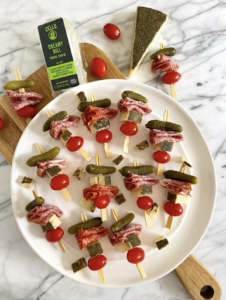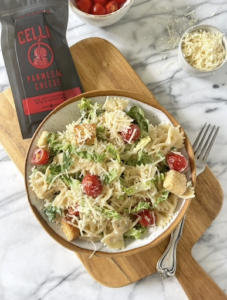This post is in partnership with Cello Cheese, but all opinions are my own.
Labor Day is the last hoo-rah of Summer, so let’s go out with a bang! I have created 3 last minute Labor Day recipes in partnership with Cello Cheese to totally wow your guests at your get-together! I love using Cello Cheese in my recipes because of their quality ingredients and handling, their wide array of products and their commitment to excellent cheese. In these recipes, I highlighted Cello Mascarpone, Creamy Dill Wedge and Parmesan- something for everyone! Click this link to browse and shop all of their cheeses!
First up, we will start with a fun ‘charcuterie skewer’. These can be made ahead of time and stored in the refrigerator, giving you time to work on your other apps and mains, and spend more time with your guests! These skewers are loaded with salty flavors- Creamy Dill Wedge, cornichons, salami and tomatoes to balance it all out. Perfect for grab and go so your guests can spend time mingling about!

Charcuterie Skewers:
Ingredients:
-Cello Creamy Dill Wedge, cut into 1 inch cubes
-Cornichons
-Salami
-Grape tomatoes
-Plastic cocktail skewers or bamboo party picks
Lay out all of your ingredients and a serving platter or Tupperware container. Add each ingredient onto the skewer and place on the tray or container. Repeat this until all ingredients are gone. Store in the refrigerator or serve immediately.
Next are the grilled peach and mascarpone crostini with hot honey. These are absolutely incredible- boasting sweet flavors from the summer peaches, crusty bread for texture, spice from the hot honey and a creamy, cooling flavor from the mascarpone. Cello Mascarpone is just that- creamy, indulgent and rich texture you want in this pairing. Your guests are going to love this one!

Grilled Peach and Mascarpone Crostini:
Ingredients:
-Cello Mascarpone
-Fresh baguette
-2 fresh, ripe peaches
-Hot Honey
Cut the baguette into 1 inch thick slices and toast them. Then spread ~1 tablespoon of the mascarpone onto each one, followed by a slice of the peach. Place on a serving tray and drizzle with hot honey. Serve immediately.
The final dish to serve your guests before the main course: Caesar Pasta Salad using Cello Parmesan cheese. This dish is so easy to make and can be made the day before. I love recipes that allow you to spend more time enjoying your party and friends. With only a handful of ingredients, this pasta salad is done in under 10 minutes, and is incredibly flavorful. Cello Parmesan is bold and nutty, elevating this pasta salad!

Caesar Pasta Salad:
Ingredients:
-1/2 cup of Cello Parmesan Grated Cheese
-1 cup of your favorite store bought or homemade caesar dressing
-1 pound bow tie pasta (or your favorite shape)
-2 cups of romaine lettuce, sliced thinly
-1 cup grape tomatoes, halved
-1 cup croutons
-grilled and diced chicken, optional
Make the pasta according to the package. Once cooked and cooled, add to a large mixing bowl. Add in the rest of the ingredients, reserving 1/4 cup of the parmesan cheese for sprinkling on top after. Mix well and add to your serving bowl. Sprinkle the remaining parmesan, cover tightly and cool in the refrigerator for at least an hour before serving.
From my table to yours, I hope you have a fun and safe Labor Day Weekend! Cheese confidently with Cello Cheese.

